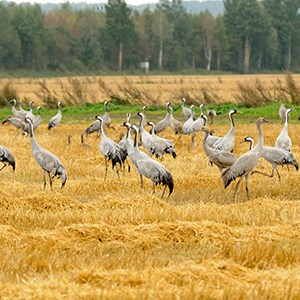New ecological knowledge of cranes can mitigate conflicts between conservation and agriculture

Lovisa Nilsson at SLU has increase the knowledge about space use and foraging site selection of common cranes. Such knowledge is needed to guide management where and when crop damage might occur, and what damage preventive measures to implement under variable environmental conditions.
Many populations of migratory cranes, geese and swans are increasing throughout Europe and North America. During migration, these birds congregate at staging sites, often located in landscapes with both wetlands and arable land.
When foraging on newly sown or unharvested crops at staging sites they frequently cause harvest losses and thus conflicts between conservation and agricultural interests.
Lovisa Nilsson´s studies are based on flock surveys and data derived from GPS transmitters in combination with field surveys of food availability and crop stages.
Natura 2000
She found that the Natura 2000 network fulfils its conservation intention for staging cranes along the flyway, but also that cranes spill over from Natura 2000 sites to surrounding arable land. This spillover may enhance the conflict between conservation of cranes and other bird species within Natura 2000 sites and agriculture.
Field selection
Her studies further demonstrated that field selection by cranes was influenced by factors dependent on agricultural practices such as crop type, crop stage, time since harvest, food availability, but also human disturbance and distance to roost site.
She further revealed an apparent mismatch between individual crane space use and current damage preventive management.
International cooperation is needed
To conclude, stubble fields with high availability of spilled grain close to the roost sites have the potential to steer cranes from unharvested crops and prevent crop damage. To mitigate conflicts between conservation and agriculture, ecological knowledge is needed, but also participatory involvement of stakeholders and international collaboration, such as a flyway management plan.